California, a state known for its diverse geography and climate, is a paradise for bird watchers and nature enthusiasts alike. From the coastal areas to the mountainous regions, the Golden State is home to a wide variety of habitats, making it a suitable home for a diverse range of bird species. One of the most captivating groups of birds found in California is the blue birds. These magnificent creatures, adorned with feathers of the most vibrant blues, can be spotted across different regions of the state.
Our Blue Birds in California Photo Guide is a comprehensive resource designed to help you identify and learn about the various species of blue birds found in this beautiful state. Complete with high-quality photographs and detailed descriptions, this guide is a must-have for anyone looking to explore the world of bird watching in California.
Blue Birds Found In California
California is a geographically diverse state, featuring a wide range of habitats from the Pacific coastline to the Sierra Nevada mountain range, and the vast Central Valley in between.
This geographic diversity, combined with the varying climates found across the state, make California an ideal home for a wide range of bird species. From the coastal areas, which are frequented by sea birds and migratory species, to the inland forests and mountain regions, which provide habitat for many resident species, there is no shortage of bird-watching opportunities in the state.
This diverse range of habitats and climates is why California is home to such a rich and varied birdlife, including the many beautiful species of blue birds.
Western Bluebird
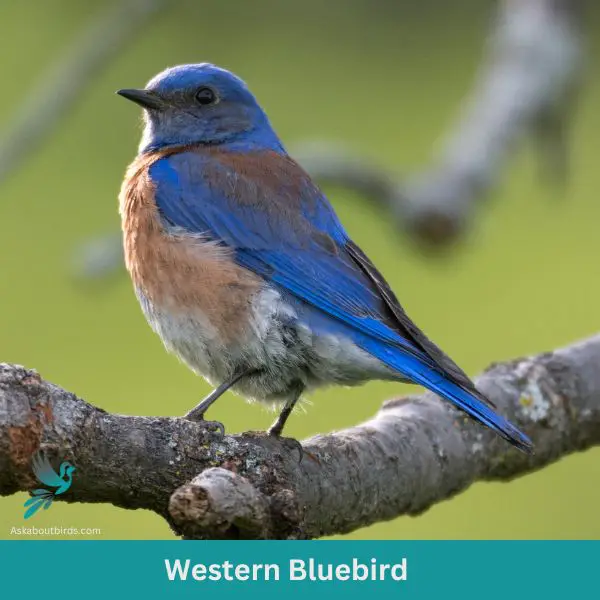
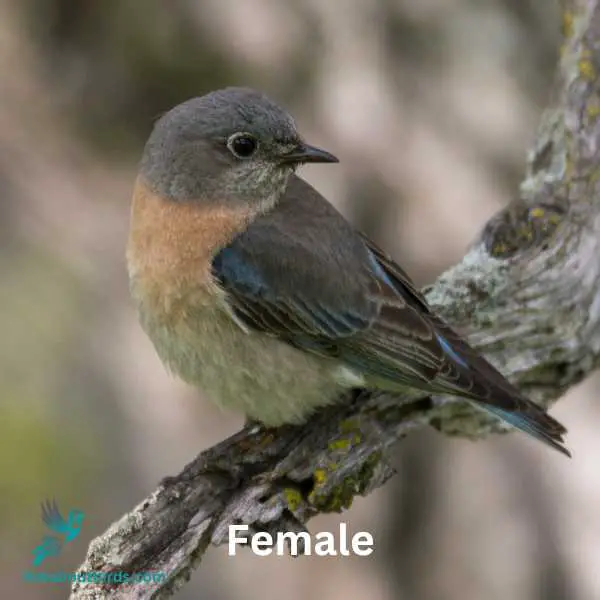
| Trait | Western Bluebird |
|---|---|
| Scientific Name | Sialia mexicana |
| Length | 5.5-7 inches |
| Wingspan | 11-13 inches |
| Weight | 0.8-1.1 ounces |
The Western Bluebird is a charismatic bird, appreciated for its vivid coloring and melodious song, commonly observed in open woodlands and meadows of the West.
Appearance: The male Western Bluebird sports a dark blue head, throat, wings, and tail with an orange breast and sides, transitioning into a grayish belly. Females are more muted, displaying grayish-blue wings and tail with a more subdued orange wash on the chest.
Diet: Western Bluebirds predominantly feed on insects, complemented by berries and fruits when available. They hunt by perching and then diving to the ground to capture their prey, and they’re also known to catch insects in mid-air.
Reproduction: These birds often utilize natural tree cavities or nest boxes for breeding. The female builds a loose nest inside and lays a clutch of 4-6 pale blue eggs.
Mountain Bluebird
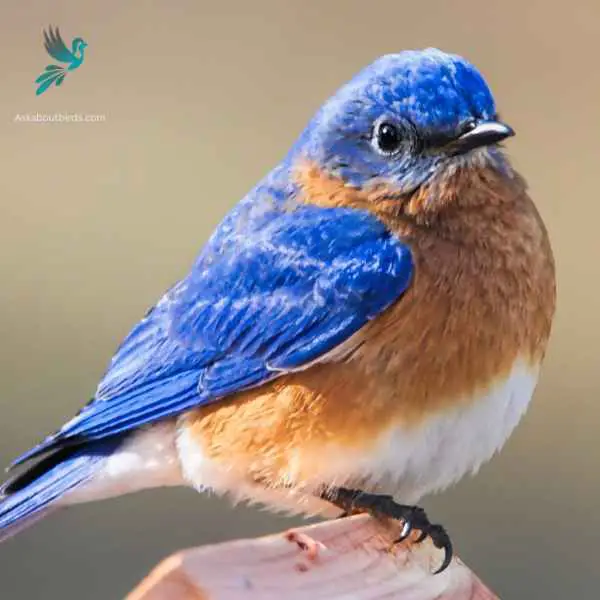
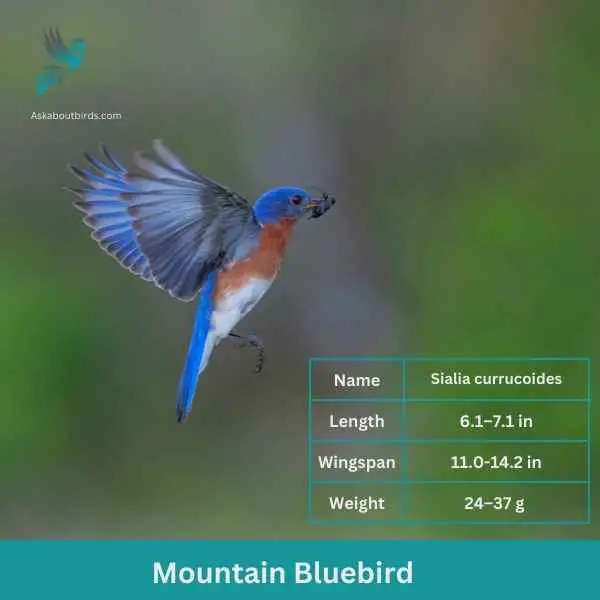
| Feature | Measurement |
|---|---|
| Scientific Name | Sialia currucoides |
| Length | 6.1–7.1 in |
| Wingspan | 11.0-14.2 in |
| Weight | 24–37 g |
The Mountain Bluebird is a small bird found in open grasslands and rocky mountains of North America. It is known for its stunning blue plumage, which is particularly vibrant in males. Females, on the other hand, have a more subdued blue coloration with hints of gray. These birds have slender bodies and a slightly curved bill, adapted for catching insects on the wing.
Mountain Bluebirds are insectivores, feeding primarily on insects such as beetles, grasshoppers, and spiders. They are skilled aerial hunters, capable of capturing their prey in mid-flight. During breeding season, these birds build their nests in tree cavities or man-made nest boxes, where females lay a clutch of eggs. The male bluebird actively participates in nest-building and provides food for the female during incubation.
California Scrub-Jay

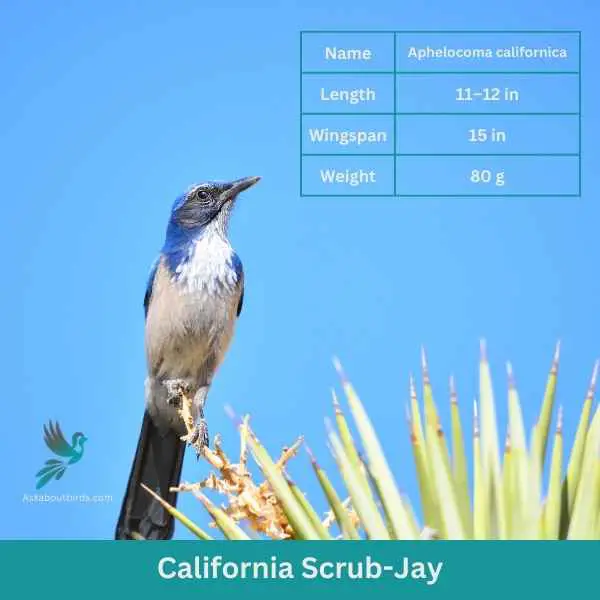
| Feature | Measurement |
|---|---|
| Scientific Name | Aphelocoma californica |
| Length | 11–12 in |
| Wingspan | 15 in |
| Weight | 80 g |
The California Scrub-Jay is a vivacious bird known for its intelligence and striking appearance, predominantly found in the chaparral, oak woodlands, and residential areas of California and parts of the Pacific Northwest.
Appearance: This jay boasts a vivid blue head, wings, and tail, complemented by a pronounced white eyebrow, a white underbelly, and a soft gray back. A distinguishing feature is the blue necklace or band across its throat and chest, which differentiates it from some other jay species.
Diet: California Scrub-Jays are omnivorous. Their diet consists of insects, fruits, seeds, and nuts, with acorns being a particular favorite. They, like their Floridian counterparts, will also cache acorns and other foods in the ground to consume later.
Reproduction: The California Scrub-Jay forms monogamous pairs. The nests, usually built between 1 to 3 meters off the ground in trees or shrubs, are constructed using twigs and lined with finer materials like hair or plant fibers. The female lays a clutch of 3 to 6 eggs that are greenish or bluish and speckled with brown.
Steller’s Jay
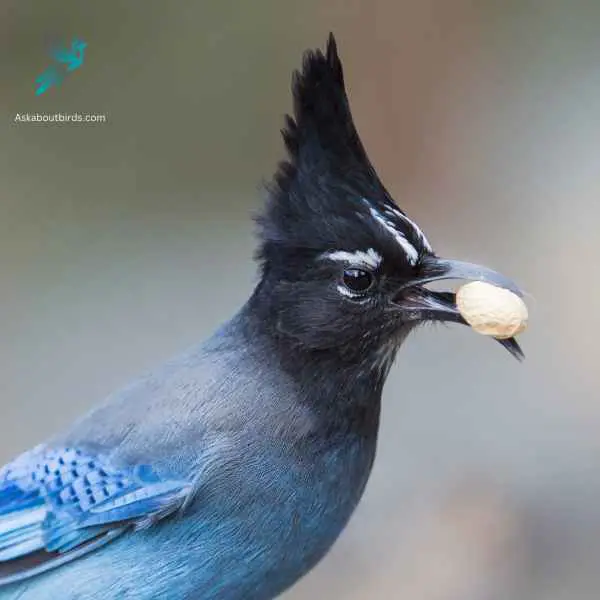

| Feature | Measurement |
|---|---|
| Scientific Name | Cyanocitta stelleri |
| Length | 12–13 in |
| Wingspan | 45 to 48 cm |
| Weight | 45 to 48 cm |
The Steller’s Jay is a charismatic and easily recognizable bird found mainly in the coniferous forests of the western North America, known for its bold behavior and loud, varied calls.
Appearance: The Steller’s Jay has a striking color contrast with a deep blue body and wings and a blackish head and upper body. One of its most distinguishing features is the tall, dark crest on its head, which can be raised or lowered depending on the bird’s mood. Its eyes are dark and its beak is strong and black.
Diet: The Steller’s Jay is omnivorous. It feeds on a wide range of items, from seeds, nuts, and berries to insects and small animals. It’s also known to raid campsites and picnics, often scavenging for human food.
Reproduction: Steller’s Jays form monogamous pairs that often remain together for several years. They typically build their nests in coniferous trees, made from twigs, moss, and other plant materials. The female lays a clutch of 2 to 6 eggs, which are usually pale green or blue with brown spots.
Western Scrub-Jay
| Scientific Name | Length | Wingspan | Weight |
|---|---|---|---|
| Aphelocoma californica | 11-12 in | 15 in | 2.8-3.5 oz |
The Western Scrub-Jay is a medium-sized bird, known for its striking appearance and intelligence.
Appearance: The Western Scrub-Jay has a blue head, wings, and tail, a gray-brown back, and a pale gray belly. The throat is whitish with a blue necklace. Males and females have similar plumage, although males are slightly larger.
Diet: The diet of the Western Scrub-Jay mainly consists of nuts, seeds, fruits, insects, and small animals. They are also known to eat eggs and nestlings of other birds.
Reproduction: Western Scrub-Jays typically nest in trees or shrubs. The female usually lays 3 to 6 eggs, which are incubated for about 16 days. Both parents feed the young and aggressively defend their nest.
Blue Grosbeak
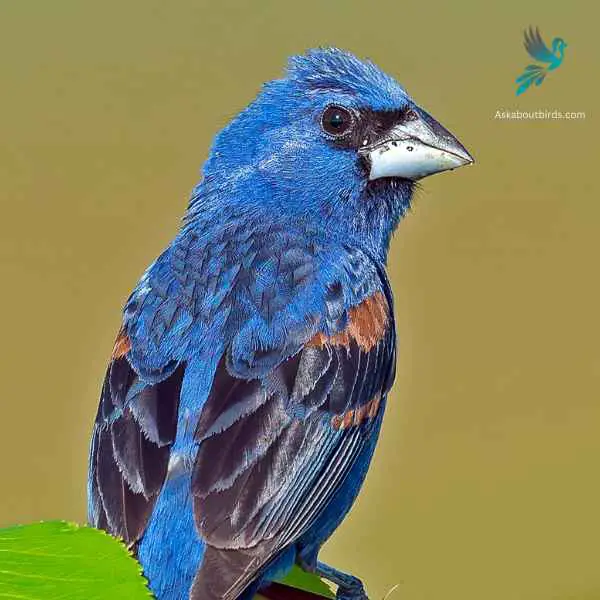

| Feature | Measurement |
|---|---|
| Scientific Name | Passerina caerulea |
| Length | 5.5 to 7.5 in |
| Wingspan | 10 to 11 in |
| Weight | 26 to 31.5 g |
The Blue Grosbeak is a medium-sized songbird found in North and Central America. The male Blue Grosbeak displays stunning plumage with deep blue feathers on its body and head, while the female has more subdued brownish tones. Both sexes have a thick, conical bill, which gives them their name “grosbeak,” meaning large beak.
These birds prefer open habitats such as grasslands, brushy areas, and woodland edges. Blue Grosbeaks are known for their melodious songs, which consist of a series of rich and varied notes. They primarily feed on seeds and insects, using their strong beaks to crack open seeds and forage on the ground or in low vegetation.
Lazuli Bunting
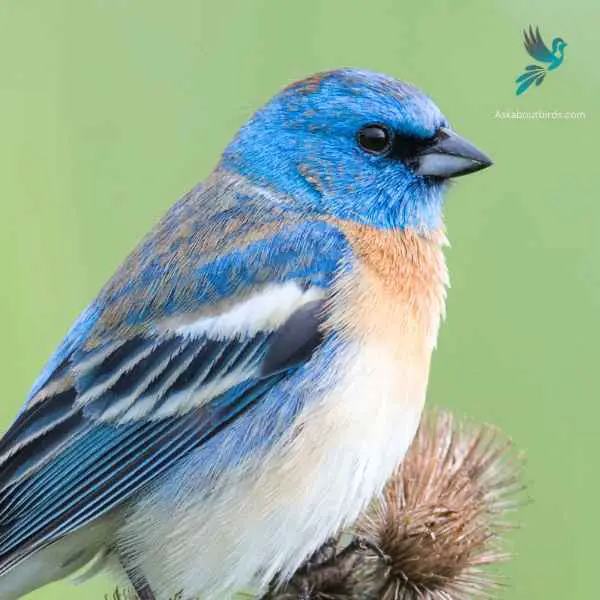

| Feature | Measurement |
|---|---|
| Scientific Name | Passerina amoena |
| Length | 5.1-5.9 in |
| Wingspan | 8.7 in |
| Weight | 13-18 g |
The Lazuli Bunting is a vibrant songbird recognized for its brilliant colors and melodious song, frequently seen in brushy areas and woodlands during the summer months.
Appearance: The male boasts a dazzling bright blue head and back, offset by a white belly and rust-orange breast. Females and immature birds present a more muted brownish hue overall, with a hint of blue on the wings and tail.
Diet: Lazuli Buntings primarily feed on seeds, but during the breeding season, they’ll also consume insects. Their strong, conical beaks are perfectly adapted for seed-cracking.
Reproduction: The female Lazuli Bunting constructs a cup-shaped nest using grasses, twigs, and other fine materials, often placing it in a shrub or low tree. She typically lays a clutch of 3-4 pale blue or white eggs.
Indigo Bunting


| Feature | Measurement |
|---|---|
| Scientific Name | Passerina cyanea |
| Length | 4.5–5.1 in |
| Wingspan | 7.1–9.1 in |
| Weight | 11.2–21.4 g |
The Indigo Bunting is a strikingly vibrant songbird, often hailed for its brilliant blue plumage and melodic song that graces woodlands and meadows during the warmer months.
Appearance: Males are renowned for their bright indigo blue feathers, which can appear darker in certain lights. Females and juveniles, on the other hand, are brown with subtle hints of blue on their wings and tail. The species lacks the vibrant streaking or spotting commonly found in many other songbirds.
Diet: Indigo Buntings primarily subsist on seeds, especially during non-breeding seasons. During the breeding season, they also consume a variety of insects such as beetles, caterpillars, and spiders, providing essential protein for their growing chicks.
Reproduction: Indigo Buntings build their nests close to the ground in shrubs or low tree branches. These nests, crafted meticulously with grasses and other plant materials, cradle clutches of typically 3 to 4 eggs. After hatching, the young are fed by both parents until they’re ready to fledge.
Barn Swallow


| Feature | Measurement |
|---|---|
| Scientific Name | Hirundo rustica |
| Length | 6.5–7.5 in |
| Wingspan | 12.5–13.5 in |
| Weight | 16–22 g |
The Barn Swallow is a sleek, agile bird renowned for its graceful flight patterns and iconic forked tail, often seen darting over fields and water bodies in search of flying insects.
Appearance: Barn Swallows have deep blue, almost iridescent, upperparts and a rufous to tawny underbelly. Their distinctively forked tail and long wings give them a streamlined look. Both males and females have a similar appearance, though males often exhibit slightly brighter colors and a deeper fork in the tail.
Diet: Barn Swallows feed primarily on flying insects, which they catch in mid-air during their agile and acrobatic flights. Their diet includes flies, beetles, moths, and other small flying insects.
Reproduction: Barn Swallows are known for building their mud nests on man-made structures, particularly barns, bridges, and eaves. The nest is cup-shaped and made from mud pellets, often lined with feathers. The female lays a clutch of 4 to 6 eggs.
Tree Swallow
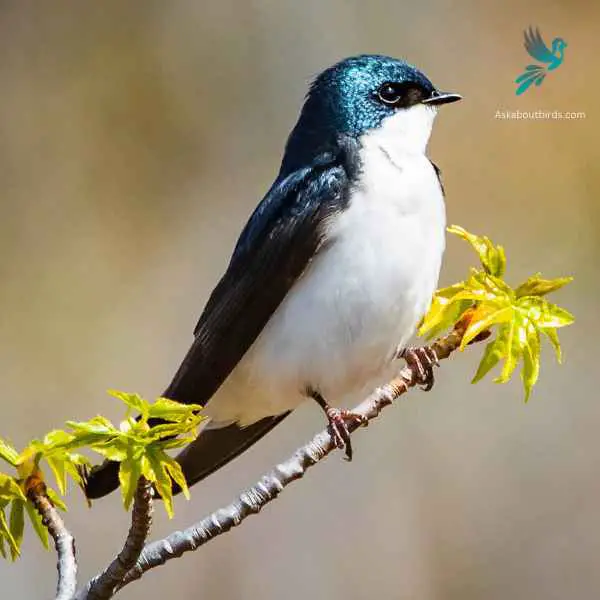
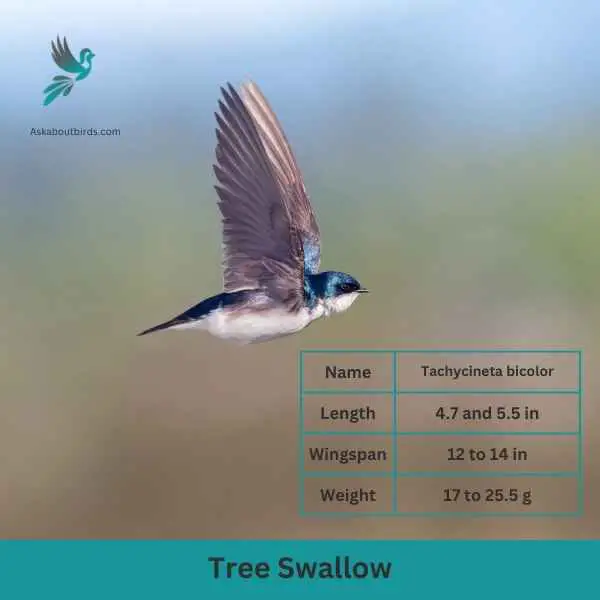
| Feature | Measurement |
|---|---|
| Scientific Name | Tachycineta bicolor |
| Length | 4.7 and 5.5 in |
| Wingspan | 12 to 14 in |
| Weight | 17 to 25.5 g |
The Tree Swallow is a graceful and agile bird, best recognized for its iridescent blue-green upperparts and sweeping flight patterns over open fields and water.
Appearance: The Tree Swallow is sleek with a streamlined body. The upperparts shine with a blue-green iridescence while the underparts are white. They possess long, pointed wings and a slightly forked tail, aiding in their agile flight.
Diet: Tree Swallows primarily feed on flying insects, skillfully catching them mid-air. During colder months when insects are scarce, they can switch to a diet of berries, particularly those of the bayberry, which other birds might find hard to digest.
Reproduction: Tree Swallows are cavity-nesters, typically choosing natural holes in trees or using bird boxes. They line their nests with feathers, creating a soft environment for the eggs. The female will lay a clutch of 4 to 7 white eggs.
Cliff Swallow
| Scientific Name | Length | Wingspan | Weight |
|---|---|---|---|
| Petrochelidon pyrrhonota | 5-6 in | 11-12 in | 0.8-1.0 oz |
The Cliff Swallow is a small, sociable bird known for its distinctive appearance and nesting behavior.
Appearance: The Cliff Swallow has a shiny blue-black back and crown, a chestnut face, and a white forehead. The underparts are buff to cinnamon, and the tail is squared or slightly notched. Males and females have similar plumage.
Diet: Cliff Swallows feed primarily on flying insects, which they catch in the air. Their diet includes a variety of insects such as flies, wasps, ants, and beetles.
Reproduction: Cliff Swallows are colonial nesters and build their mud nests on vertical cliffs or structures like bridges and buildings. The female lays 3 to 6 eggs, which are incubated for about 14 to 16 days. Both parents feed the young and defend the nest.
Belted Kingfisher

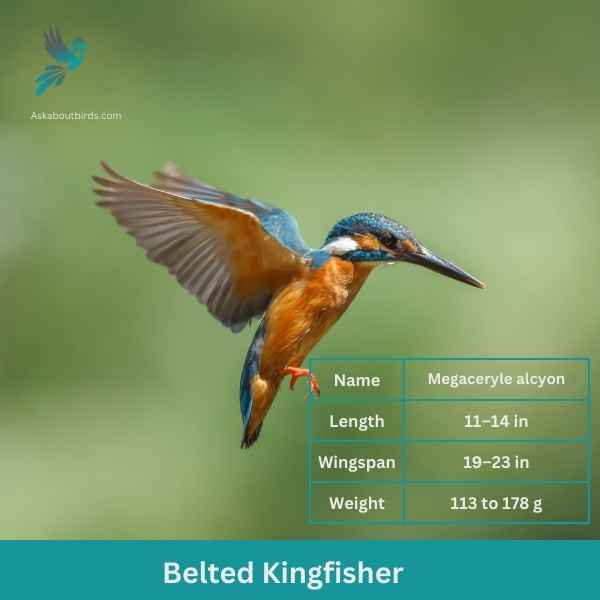
| Feature | Measurement |
|---|---|
| Scientific Name | Megaceryle alcyon |
| Length | 11–14 in |
| Wingspan | 19–23 in |
| Weight | 113 to 178 g |
The Belted Kingfisher is a distinctive and easily recognizable bird, frequently observed near water bodies, where it can be seen diving headfirst to catch prey.
Appearance: Sporting a prominent crest, the Belted Kingfisher has a slate blue-gray upper body and white underparts. Males possess a single blue band across their white chests, while females have an additional rufous band, making them one of the few bird species where females are more brightly colored than males. Their bill is long, sharp, and dagger-like.
Diet: As expert fishers, Belted Kingfishers mainly prey on small fish, but they’ll also consume crustaceans, insects, and amphibians. They’re known for their hunting tactic of hovering over water, spotting their prey, and then diving swiftly to snatch it.
Reproduction: Belted Kingfishers nest in burrows which they excavate in sandy or earthen banks, usually adjacent to water. The tunnel can be anywhere from 3 to 6 feet long, ending in a chamber. Within this chamber, the female lays a clutch of 5 to 8 white eggs.
Purple Martin
| Scientific Name | Length | Wingspan | Weight |
|---|---|---|---|
| Progne subis | 7.5-8.7 in | 15.3-16.1 in | 1.6-2.1 oz |
The Purple Martin is the largest North American swallow known for its acrobatic flight and sociable behavior.
Appearance: Adult male Purple Martins have iridescent, dark blue-purple plumage overall, while females and young have a duller, grayish-brown upperparts and white underparts with a grayish chest. The wings and tail are blackish.
Diet: Purple Martins feed almost exclusively on flying insects, including dragonflies, damselflies, flies, beetles, wasps, and moths. They catch their prey in the air, often flying high and covering large distances in search of food.
Reproduction: Purple Martins are cavity-nesting birds and have come to rely on human-provided nesting structures in the eastern parts of their range. The female lays a clutch of 3 to 6 eggs, and incubates them for about 15 to 18 days. Both parents feed the young and defend the nest.
Little Blue Heron
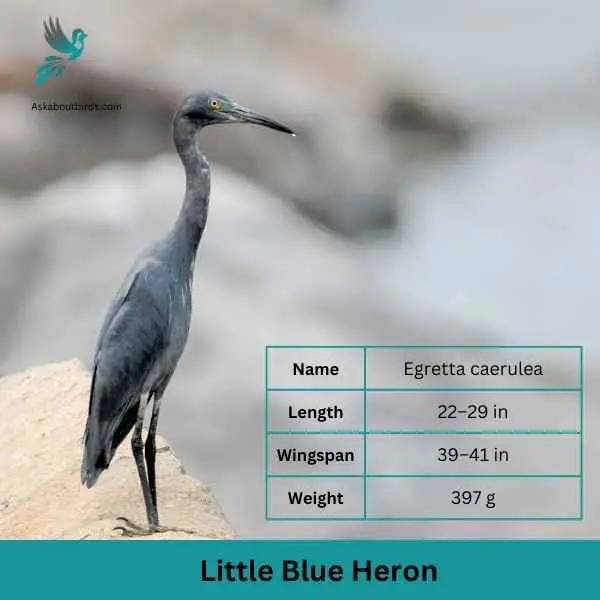
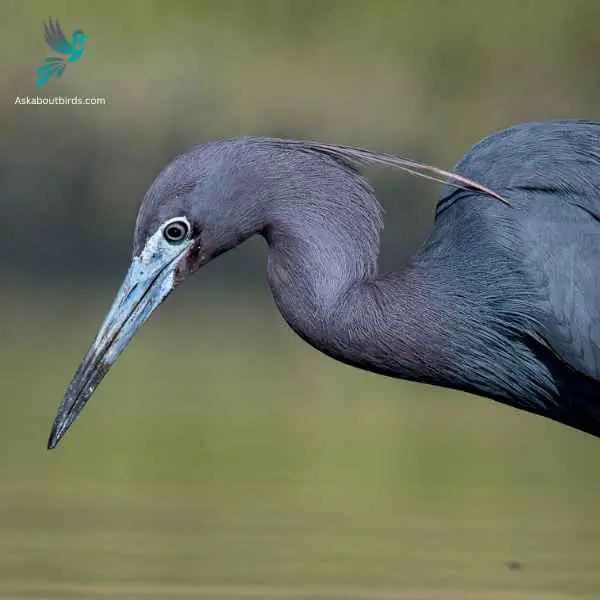
| Feature | Measurement |
|---|---|
| Scientific Name | Egretta caerulea |
| Length | 22–29 in |
| Wingspan | 39–41 in |
| Weight | 397 g |
The Little Blue Heron is a slender and elegant wading bird, often seen foraging in freshwater or saltwater habitats, especially in the southeastern parts of the United States.
Appearance: This heron undergoes a fascinating color transition as it matures. Juvenile Little Blue Herons are white, but they gradually acquire the slate-blue plumage that characterizes adults. The adult has a dark blue-gray body with a purplish neck and head. Their bill is grayish with a black tip.
Diet: The diet of the Little Blue Heron consists mainly of small fish, but they also feed on crustaceans, insects, and other small aquatic animals. Using stealth, they slowly stalk their prey in shallow waters before striking with their long, sharp bill.
Reproduction: Little Blue Herons nest in colonies, often with other wading birds. They build platform nests in trees or shrubs close to water bodies. The female typically lays a clutch of 3 to 5 pale blue eggs. Both parents participate in incubation and feeding the chicks once they hatch.
Where to Spot California’s Blue Birds
California is a bird watcher’s paradise, offering a vast array of habitats that attract a diverse variety of bird species. Here are some of the top locations in the state known for their great bird-watching opportunities, particularly for spotting blue birds:
- Point Reyes National Seashore: Located on the coast of northern California, Point Reyes is a major stopover point for migratory birds along the Pacific Flyway. It is home to over 490 bird species, including several species of blue birds.
- Big Sur: This rugged stretch of coastline in central California is not only breathtakingly beautiful, but it is also a great spot for bird watching. The coastal chaparral and redwood forests provide habitat for a variety of bird species, including the California Scrub-Jay.
- Yosemite National Park: This iconic national park in the Sierra Nevada mountains is home to a wide variety of wildlife, including over 260 bird species. The mountain bluebird, a beautiful bright blue bird, can often be spotted here.
- Bolsa Chica Ecological Reserve: Located in southern California, this coastal wetland is a hotspot for bird watching. Over 300 bird species have been recorded here, including the vibrant Western Bluebird.
- Salton Sea: This inland saline lake in southern California is one of the most important bird areas in the western United States. It is a key stopover point for migratory birds and is home to over 400 bird species, including several species of blue birds.
| State’s Blue Birds | Top Spots for Blue Birds |
|---|---|
| Oregon’s Blue Birds | 1. Malheur National Wildlife Refuge 2. Mount Hood National Forest 3. Oregon Dunes National Recreation Area |
| Nevada’s Blue Birds | 1. Great Basin National Park 2. Lake Tahoe Nevada State Park 3. Red Rock Canyon National Conservation Area |
| Arizona’s Blue Birds | 1. Chiricahua National Monument 2. Madera Canyon 3. Saguaro National Park |
FAQs on Blue Bird Species Found in California
What is the most vibrant blue colored bird?
The Blue Jay is one of the most vibrant blue colored birds you can come across. It has a rich blue color on its upperparts and a white belly. Apart from its striking appearance with a blue crest, dark blue wings, and tail, and a white face and underparts, it is also known for its intelligence and complex social systems. Another bird with a vibrant blue color is the Indigo Bunting, which is entirely dark blue body during the breeding season. Both these birds will definitely catch your eye with their bright and rich blue plumage.
Do blue-colored birds visit bird feeders?
Yes, many blue colored birds visit backyard bird feeders. Blue Jays, for instance, are known to frequent bird feeders and enjoy a diet of sunflower seeds, cracked corn, and peanuts. Similarly, the Eastern and Western Bluebirds, although primarily insectivorous, will also visit bird feeders to eat fruits and mealworms. Another blue colored bird, the Woodhouse’s Scrub Jay, also visits bird feeders and enjoys sunflower seeds, peanuts, and white proso millet. Therefore, if you have bird feeders stocked with these foods, you might be lucky enough to spot some beautiful blue colored birds in your backyard.
What do blue colored birds eat?
Blue colored birds, such as the Blue Jay, Woodhouse’s Scrub Jay, and Blue-gray Gnatcatcher, have varied diets. Blue Jays are known to eat a wide variety of foods including sunflower seeds, cracked corn, peanuts, fruits, and even small invertebrates. Woodhouse’s Scrub Jays primarily eat acorns, nuts, and seeds, but will also consume insects, fruits, and eggs. The Blue-gray Gnatcatcher primarily eats insects and spiders. While their diets vary significantly, many blue colored birds consume a combination of insects, seeds, and fruits.
How can I attract blue colored birds to my backyard?
To attract blue colored birds to your backyard, it is important to provide them with their preferred food in bird feeders. For example, Blue Jays are attracted to sunflower seeds, peanuts, and cracked corn. Additionally, provide clean water sources and suitable nesting sites. Planting native trees and shrubs that produce small fruits can also attract them. Installing birdhouses can provide nesting sites for cavity-nesting blue colored birds like the Eastern and Western Bluebirds. Providing a bird-friendly habitat with a variety of food, water, and shelter will increase your chances of attracting blue colored birds to your backyard.
